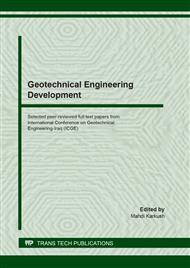[1]
H. Brandl, Energy foundations and other thermo-active ground structures, Géotechnique. 56(2) 81–122 (2006).
DOI: 10.1680/geot.2006.56.2.81
Google Scholar
[2]
S.X. Chen, Thermal conductivity of sands, Heat Mass Transfer. 44(10) 1241–1246 (2008).
DOI: 10.1007/s00231-007-0357-1
Google Scholar
[3]
V.R. Tarnawski, T. Momose, W.H.. Leong, G. Bovesecchi and P. Coppa, Thermal Conductivity of standard sands: Part I; dry-state conditions. Int. J. Thermophys 30:949–968 (2009).
DOI: 10.1007/s10765-009-0596-0
Google Scholar
[4]
U. Hammerschmidt, Guarded hot-plate (GHP) method: Uncertainty assessment, Int. J. of Thermophysics. 23(6) 1551-1570 (2002).
Google Scholar
[5]
B. Pilkington, S. Grove, Thermal conductivity probe length to radius ratio problem when measuring building insulation materials, Const. and Build. Materials J. 35 (2012) 531–546.
DOI: 10.1016/j.conbuildmat.2012.04.108
Google Scholar
[6]
S. Doran, Field investigations of the thermal performance of construction elements as built, Building Research Establishment Client Report No. 78132. BRE East Kilbride. UK, (2000).
Google Scholar
[7]
V.G. Onishchenko, I.S. Lisker, A.G. Georgiadi, A generalized description of soil thermal conductivity, Eurasian soil science. 32(2) 185-8 (1999).
Google Scholar
[8]
ASTM International. Subcommittee D18. 12 on Rock Mechanics. Standard test method for determination of thermal conductivity of soil and soft rock by thermal needle probe procedure. ASTM International (2008).
DOI: 10.1520/d5334-05
Google Scholar
[9]
M.N. Ozisik, Boundary Value Problems of Heat Conduction. Courier Corp, Dover Phoenix Editions (2002).
Google Scholar
[10]
J.C Jaeger, Conduction of heat in an infinite region bounded internally by a circular cylinder of a perfect conductor, Aust. J. Phys. 9 (1956) 167-179.
DOI: 10.1071/ph560167
Google Scholar
[11]
B. Vos, Analysis of thermal-probe measurements using an iterative method to give sample conductivity and diffusivity data, Appl. Sci. Res. (1955) 425–438.
Google Scholar
[12]
O. Johansen, Thermal conductivity of soils, Cold Reg. Research and Eng. Lab. Hanover Ph.D. Thesis, (1977).
Google Scholar
[13]
ASTM, American Standard of Testing and Materials, ASTM (2011). D2216-19.
Google Scholar
[14]
B. Pilkington, In situ measurements of building materials using a thermal probe, PhD, University of Plymouth, England (2008).
Google Scholar
[15]
R. Coquard, D. Baillis and D. Quenard, Experimental and theoretical study of the hot-wire method applied to low-density thermal insulators, Int. J. of Heat and Mass Transfer 49 (2006) 4511–4524.
DOI: 10.1016/j.ijheatmasstransfer.2006.05.016
Google Scholar


